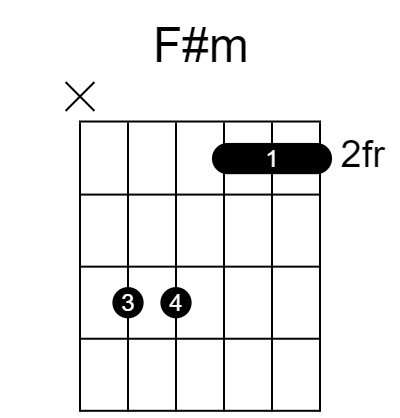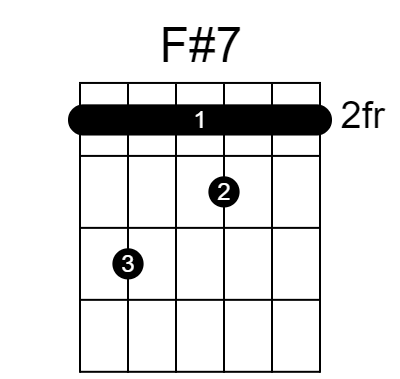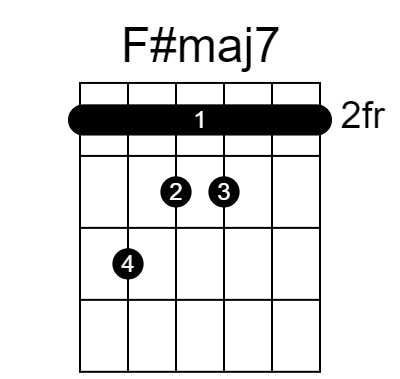Bar chords allow you to play any type of chord, anywhere on the neck, in any key.
If you learn how to play bar chords on guitar, then most chord progressions you ever meet will be easier to play than Uno. (Other card games are available…)
Even just learning one bar chord shape will provide you a whole new level of gymnastic, musical flexibility.
In this post, I’ll go over all the different bar chord shapes and the ones you should learn for the most success.
In the beginning, learning the basic open chords will serve you well. But as you start to progress, you’ll notice that you wanna play chords like F# and Bm.
You go to learn them and then realise they don’t actually exist…
Unless you play them as bar chords.
So what the heck are these things?
What are Bar/Barre Chords?
Bar chords are essentially a way of shifting those open position chords that you learnt earlier up the fretboard.
For example, an F# chord has the notes F# A# C#.
And none of these notes can be played using open strings EADGBE.
So an open position F# chord literally doesn’t exist.
Think about it, an E chord has E G B, a C chord has C E G and an A has A C# E.
In fact, all the open position major chords that you know will have at least one or two notes in the chord in common with the open strings EADGBE.
But F#? Nope.
So we have to get creative and make sure that every string we play is either being pressed down or muted.
The two ways we can play this chord are either to put a capo on fret 2 (because fret 2 on the E string is F# – I’ll explain more on that later) and play our regular E chord shape again…

Or, we can use our index finger to act as a natural capo and press down all those strings instead:

So why can’t I just use a capo all the time?
Great question, young Padawan…
Here’s the thing, capos are great for playing the chord progressions that you would normally play as open chords.
The capo allows you to shift these chord progressions to higher keys.
This is normally so people can modify songs to suit their vocal range or the octave they want to sing in.
Bar chords however, are much more mobile and unchain you from using a capo or open chords.
They allow you to play any sequence of chords in any key really easily.
For example, if you’re in the key of E and you wanna play F#m, its just not gonna work if you try to fling the capo on fret 2 to play F#m and then rapidly attempt take it off to play the next chord.
Unless looking like a fool is your lifelong dream. In which case, go ahead!
Anyway, your index finger basically acts a mobile capo.
It’s a little bit tricky to begin with but it’s REALLY worth getting good at these bad boys.
You’ll have the power to make Dominant 7th, Minor 7th, Major 7th and other endless possibilities of chords at your fingertips.
Literally….
The Bar Chord Shapes You Should Know
Alright, so these are the bar chords that I think you should learn to play on guitar:
- Major
- Minor
- Dominant 7th
- Minor 7th
- Major 7th
AHHHHHHHH that’s so many chords! I think my brain is about to explode AHHH!
Alright, yup I get that’s pretty scary…
But the great thing about bar chords is that once you learn one chord shape, you can use that same shape to play any chord at all.
That means that – in reality – you only need to learn 5 shapes!
Oh boy! Really?
Nah, just teasing. There are two versions of each shape (major, minor etc.) so you actually need to learn 10.
But that’s still not too bad at all.
And anyway, if you learn to play these bar chords on guitar then you’ll be able to play almost every chord progression ever created.
Except pain-in-the-ass jazz progressions. I’m tellin ya, it’s like playing twister with your fingers…
How to Play the Major Bar Chords
Alright, so I’ve waffled on for long enough, let’s get your fingers into action.
To play a major bar chord, start by playing a standard E major chord like this, leaving your index finger free:

Then slide that shape up two frets higher and press your index finger down across the entire 2nd fret.
You want to make sure that it presses down all 6 strings so that they ring out clearly.
Then play each string one by one to check they sound good and voila!
You have just played an F# major chord.
WOOHOO! *Party popper sounds*

We call this one the “E shape” because it’s based off a standard E chord.
If you want to play a Bb/A# major chord instead then all you have to do is slide this same shape up to the 6th fret.
This is because there is a Bb/A# on the 6th fret of the low E string, which we use as our bass note in this shape.
On the 10th fret of the low E string is a D note.
This means if we shift this shape up to the 10th fret then we have a D major chord.
Bar chords are normally named after their lowest/bass note.
With this in mind, to play the other bar chord shape, play a standard A major chord like this:

We call this the “A shape” because it’s based of an A chord.
This time, the low E string is muted, so the bass note is the open A string.
This means that if we want to use this A shape to make a bar chord, the bass note needs to be on the A string.
F# happens to be on the 9th fret of the A string so we can use this as our bass note this time.
Slide the A chord up and flatten your index finger down across the 9th fret and you have the other major shape:

You could also play it like this by using your ring finger to bar the three notes down like this if you want:

Just choose whichever one you prefer.
Try switching between the E and the A shapes for F# and you will realise that the notes in each are exactly the same.
They may sound slightly different because they’re played in different places, but the chords themselves are identical.
Ok, great. But what’s the point of learning two different shapes?
Well, imagine you have a chord change of F# to B and you wanna play them both with the E shape.
You start by playing the F# in the E shape and you’re having a jolly-old time.
But then to play the B, you have to slide all the way up to the 7th fret to where the B note is on the E string.
And this is, like, 500 miles away!
Changes like this mid song get very messy and your girlfriend would probably dump you for it.
Butttttt…. there is a B note on the 2nd fret of the A string.
If we use this as our bass note instead, we can play the A chord shape.
Now we have the ability to play a B chord on the 2nd fret.
This means we can switch from F# to B without even needing to move our hand anywhere!
Oh my! Wow! That’s amazing! Cheers Sam! You’ve just saved my relationship!!!!
Anytime.
That’s why I highly recommend learning the notes on the low E and A strings.
It helps you plan out where and how to play each chord in a progression, saving you from those messy changes.

I hope that makes sense.
These rules apply to all the other bar chord shapes (Minor, Dominant 7th etc.). We just need to alter both the shapes to get the different sounds.
How to Play the Minor Bar Chords
Very similar to the major shapes, we just need to flatten the major 3rd in each chord to make them minor.
But we still have two shapes, this time based off Em and Am:

Oooooooh, that’s nasty.
That minor 3rd on the G string is every guitarist’s worst nightmare to play.
You’re gonna need some proper pincer muscle strength (more tips on that later) to get it ringing out clearly.
If this is too difficult currently and you’re in an SOS situation, then we can skip the bass note as an exception and play the chord like this:

It still works, and the whole chord is in the same place that we would normally use.
We just cheat and sacrifice the bass note in this case so that we can easily make that minor 3rd ring out.
Isn’t that, like, illegal or something?
Yup.
Anyway, here’s the second shape, you’ll notice that it’s basically an Am chord that’s been slid up the fretboard:

It’s the easiest out of the four so that one hopefully shouldn’t cause too much mayhem.
If it does then you may wish to reconsider your life choices that’s perfectly okay 🙂
How to Play Dominant 7th Bar Chords
As much as I love the idea of all you lovely people learning to play 7th bar chords on guitar, you shouldn’t learn them… until you feel really comfortable with the major and minor variants.
Get good at those first and learning these will be a breeze.
(I mean, literally all you gotta do is take a finger off)
Here’s the first shape:

And this is the second shape:

See what I mean?
Literally just taking a finger off.
Give those a go and you’ll be-bop-ing your way to jazz town!
Ew, what was that? An attempt at a pun?
Uhhhh… well… haha…
How to Play Minor 7th Bar Chords
Okay! Swiftly moving on, let’s take a look at the minor 7th bar chord shapes…
Using the same logic as before, all we gotta do is lift a finger off from the minor shapes to turn them into minor 7ths:

Like with the first minor shape, you may want to skip the bass note and play the chord like this if you find it too tricky:

And here is the second shape:

There we go, another two chords in the bag.
And they weren’t too bad, right?
Meh.
Well, just wait ’till you get your hands on the major 7th bar chords!
How to Play the Major 7th Bar Chords
Undoubtedly the fiddliest ones, these may take a little while to get used to.
This first shape isn’t really a bar chord but it’s the shape I recommend:

Unless you’d prefer to play it like this of course:

Didn’t think so lol.
Anyway, here is the second shape:

And there you have it.
You now know all 10 bar chord shapes.
But how to do actually get good at them quickly?
How to Practice Bar Chords
There are two parts that you will need to train to play bar chords well on guitar.
The first one is the “pincer muscle”:
The stronger this muscle is, the easier it feels to bar/barre multiple strings down on the guitar.
The best way that I’ve found to train this muscle is to get a cheap bouncy ball and do reps of squishing it. Like this:

You can see that you’re actively working this “pincer muscle” and within a couple of weeks you’ll have a buff looking left hand.
But the best part is that you can do loads of reps without even thinking about it.
Whilst you’re watching TV, on the bus or brushing your teeth are great times to get some easy reps in.
If you can’t get a bouncy ball for whatever reason, then just make sure you practice bar chords frequently.
Your “pincer muscle” will gradually get stronger.
The second part that you need to train to play bar chords on guitar is your muscle memory.
Everything will feel awkward to begin with so we wanna get rid of that feeling asap.
To get them feeling comfortable quickly I suggest using The switch method.
Someone really needs to find me a better name for that.
If you’ve read my other posts on how to play the basic chords and how to play 7th chords, you will know that I’m a big fan of this method because it just works so well:
- Find 2 chords that you are trying to learn. E.g. F# (E shape) and B (A shape)
- Switch between them continuously for a few minutes. F# to B to F# to B to F#
- Have a break and do it again until these changes feel comfortable.
- Add an extra chord to the mix. E.g. Dm (Am shape)
- Switch from F# to Dm to B to F# to Dm to B for a few minutes
- Once this feels comfortable add another chord. E.g. Bbm (Em shape)
Boom! After this you’ll have both shapes of the major and minor bar chords in the bag.
Once you have a set of 4 chords that you are comfortable switching between, make a new set with 2 new chords.
You then repeat the process until you have another 4 chords in the bag.
(I wouldn’t have more than 4 chords in a set though. Otherwise, you don’t get enough reps of each new chord you add.)
This is a super efficient way of learning new chords and within a couple of weeks you’ll be a bar chord maestro.
Wrapping It Up
All these chords are all super useful, and you are bound to use them more than you eat breakfast.
You’ll be able to jam with bandmates more easily, write more exciting chord progressions and access more rhythmic strumming patterns too.
And who doesn’t want that?
But don’t try and learn all of them at once, it’s just not gonna be fun.
Tick them off one by one and you’ll have these chords under your belt before you can say, Thanks Sam, you‘re the best!
Awww, you flatter me… have fun!
P.S. If you want to learn how to get riffing, then click here to learn how to play power chords and start playing your favourite songs.





Pingback: 7 Simple Ways to Play an F Minor 7 Chord on Guitar - Beast Mode Guitar
Pingback: How to Play 9th Chords on Guitar Fast - Beast Mode Guitar